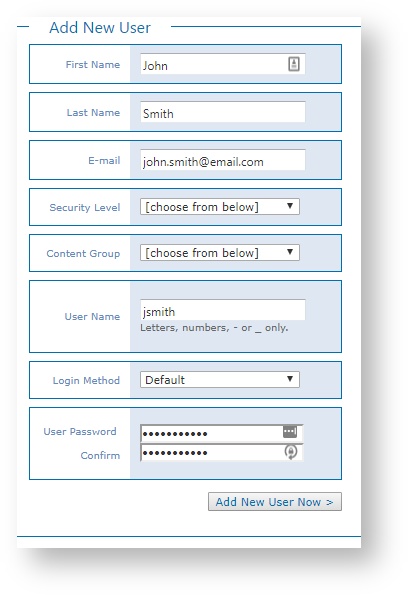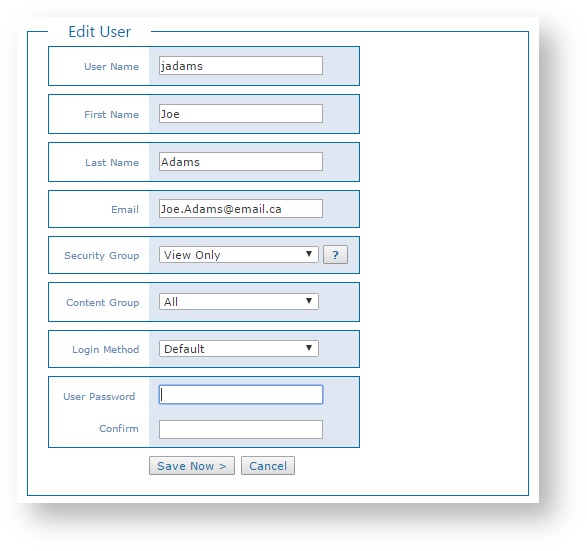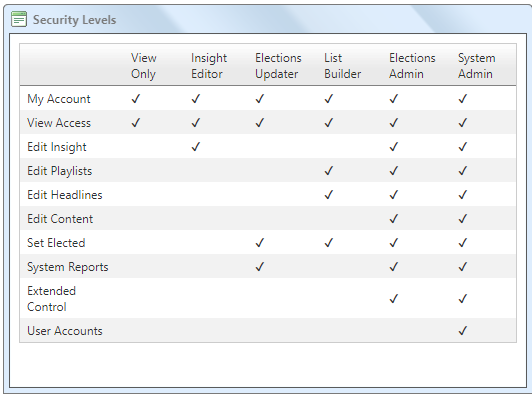User Management
Every person who needs access to Flow needs a user account in the system. Each user account is assigned user credentials including a User Name and Password as well as a role to control what that actions that user can perform in the system. Note that an LDAP login can be used in combination with the Flow user account to avoid the need for a unique Flow user name and password.
As part of the installation, Flow comes pre-installed with a System Administrator user by default. This System Administrator user account can be used to access Flow and create new and manage existing users as well as assign user permissions.
Add Users
You can create new user accounts and assign those users specific access in Flow.
- From the Home page, select System Tools > Add User.
- Enter the user’s First Name, Last Name, and Email in the fields.
- Configure the user’s access in the system by selecting a Security Level option from the list. See Elector Security Levels for details.
- Select a content group that they will belong to - if applicable.
- Enter the User Name to sign in to Flow. The User Name can contain characters, numbers, dashes, and underscores. No other special characters are allowed.
- Select a login method
- Default uses a Flow defined user name and password.
- LDAP logins can be enabled
- Enter the user's Password twice (if required). Both passwords must match.
- Click Add New User Now.
Your system is only as secure as the passwords for your user accounts. It is highly recommended that you use strong passwords for all Flow user accounts. The strongest passwords include a long combination of letters, numbers, uppercase, lowercase, symbols, and other special characters. Use a password that you have not used for any other online account.
Manage Users
Flow administrators can manage system user accounts as well as manage system access per account.
From the Home page, select System Tools > Manage Users.
Note: The System Administrator user account, created as part of the initial installation, cannot be modified or removed. However, the password can be changed.
Current Users
The list of current users details existing user information, whether or not the user account is enabled, the date the user account was added, and the last time the user signed into the system.Notes:
- Click on a column header to sort in ascending or descending order. Click a second time to sort in the reverse order. Click a third time to remove the sorting.
- Filter the list of users by: User Name, First Name, Last Name, Email, Security Group, Content Group, Date Added, or Last Activity.
Modify Users
You can modify user information as well as enable or disable user accounts.Click Edit to modify the user account.
- Modify user account information as needed.
- Modify user access as needed. Click the Help (?) button to see the Flow module access for each role in the Security Levels dialog.
- Select or clear the Enabled option to enable or disable the user account in Flow. Disabled users cannot sign into the system or access any Flow functionality; however, should the user account be needed in the future, it can be re-enabled instead of re-created.
- Enter a new User Password for the user, if needed. Enter the password again to confirm. Both passwords must match.
Click Save Now.
Remove Users
Click Remove to remove the user account. Click OK to confirm.
Tip: To avoid removing the user account entirely from the system, consider disabling the user account instead. See Modify Users above for details.
Elector Security Levels
To assign a Security Level for a user account in Flow, review the Security Levels dialog to see the Flow module access for each role, and then select a role from the list.
Extended Control Privilege
Has the following special privileges
- Remove candidate
- Remove party
- Remove riding
- Edit riding ID number
- Flag a riding as new using toggle button in Riding Management
- Edit party data feed ID values
- Declare the winning party and government type.
- Manage Regions for non-current elections.
- Manage Ridings for non-current elections
- Access the Generate Extra Riding Names feature in the Riding Management module
- Access the Generate Previous Riding Connections feature in the Riding management module
- Manage Watchlist Groups
Elector Content Groups
Users can be assigned to a content group. Content groups are used to provide group specific content to users who need it. For example this is used with the Watchlist groups and the Playlist Bins.
Watchlist groups can be assigned to a content group. If a user is also assigned to that content group they will see the group and its watchlists. This reduces the clutter for a user allowing them to focus on the content important to them.
Watchlist groups can be assigned to content groups.







